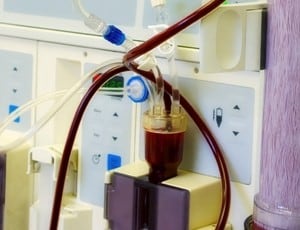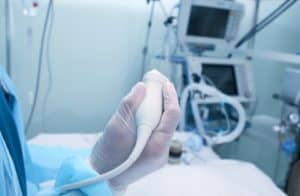Comparative vascular access data for pediatric clinicians and organizations

To determine the range and heterogeneity of VA outcome measures or quality indicators reported in randomized controlled trials (RCTs) and clinical registries, to inform development of a homogeneous, reliable, minimum dataset for a pediatric VA registry” Schults et al (2019). Abstract: BACKGROUND: Internationally, there is a lack of comparative vascular access (VA) data for pediatric […]
Acute tibial osteomyelitis caused by intraosseous access

We report a case of massive acute tibial osteomyelitis in an adult male three months after an IO catheter insertion for emergency drug infusion” Chalopin et al (2018). Abstract: BACKGROUND: Intra-osseous (IO) access is recommended in cases of pre-hospital emergency or resuscitation when intravascular (IV) route is difficult or impossible. Despite recent improvement in IO […]
How to prevent inadvertent central venous catheter dislodgement
Sometimes patients inadvertently dislodge or pull out central venous catheters; in other cases, they are removed intentionally by patients who are confused” Brown and Kim (2018). Background: Sometimes patients inadvertently dislodge or pull out central venous catheters; in other cases, they are removed intentionally by patients who are confused. Although this behavior is uncommon, it […]
Next-generation sequencing to identify central catheter tip pathogens

This preliminary clinical study aimed to examine whether next-generation sequencing (NGS) targeting 16S rDNA, which was PCR-amplified directly from the tip of a central venous catheter (CVC), can be used to identify causative pathogens in CRI, compared to the culture method” Okuda et al (2018). Abstract: BACKGROUND: Catheter-related infection (CRI) is one of the serious […]
Making good use of blood culture time-to-positivity

Needs to develop early de-escalation stewardship strategies for controlling selective pressure and to better and promptly identify patients with poor outcomes who should benefit from more aggressive treatment have promoted research on blood culture time-to-positivity (TTP)” Lamy (2018). Abstract: Needs to develop early de-escalation stewardship strategies for controlling selective pressure and to better and promptly […]
One-sheath inverse method in vascular access intervention therapy for hemodialysis

A one-sheath inverse method is useful. We hope that the technique will be more widely recognized, allowing the technique to be applied to more cases” Takashima et al (2018). Abstract: INTRODUCTION: Vascular access intervention therapy (VAIVT) is an essential interventional therapy in the field of hemodialysis therapy that allows for the long-term vascular access functionality […]
Study identifies that skin microorganism load was significantly lower at the upper arm or chest

Skin microorganisms may contribute to the development of vascular access device (VAD) infections. Baseline skin microorganism type and quantity vary between body sites, yet there is little evidence to inform choice of VAD site selection” Marsh et al (2018). Abstract: Background: Skin microorganisms may contribute to the development of vascular access device (VAD) infections. Baseline […]
Decreasing blood culture contaminants in pediatric emergency departments

Interventions that focused on improving venipuncture technique and limiting unnecessary blood cultures were associated with fewer contaminants and the achievement of the QI team’s project aims” Mullan et al (2018). Abstract: INTRODUCTION: High peripheral blood culture contamination rates (BCCR) in the emergency department (ED) contribute to overuse and harm. This study describes 2 years of […]
Risk of death after first-time blood stream infection in dialysis patients

The mortality following blood stream infection (BSI) and risk of subsequent BSI in relation to dialysis modality, vascular access, and other potential risk factors has received relatively little attention” Nelveg-Kristensen et al (2018). Abstract: BACKGROUND: The mortality following blood stream infection (BSI) and risk of subsequent BSI in relation to dialysis modality, vascular access, and […]
Central venous access catheter tunnel rupture

We describe two cases of an equal complication of a tunnel infection wherein the catheter becomes naked after self-rupture of the purulent secretion” Borisov et al (2018). Abstract: INTRODUCTION: Infectious complications are the most common chronic complications observed in patients undergoing hemodialysis with central venous catheters. However, despite the efforts of a large number of […]
Faculty opinions concerning ultrasound utilization in the emergency department

As point-of-care ultrasound (POCUS) is becoming increasingly pervasive in the emergency department (ED), ultrasound is being incorporated into medical education targeting every stage of training: medical school, residency, and fellowship [1-4]” Graglia et al (2018). Abstract: As point-of-care ultrasound (POCUS) is becoming increasingly pervasive in the emergency department (ED), ultrasound is being incorporated into medical […]
Quality improvement initiative reduces the occurrence of PICC complications

The vascular access team of 1 midwestern hospital used a quality improvement initiative to reduce the occurrence of complications associated with PICCs” Walters and Price (2019).
Article focusses on drugs that are hazardous to health care personnel

Antineoplastic and other hazardous drugs present a risk to health care personnel if they are not contained by appropriate facility design, personal protective equipment, and work practices that support safety” Kienle(2019). Abstract: Antineoplastic and other hazardous drugs present a risk to health care personnel if they are not contained by appropriate facility design, personal protective […]
Literature review of the pulsatile flushing technique

Recently, in vitro studies regarding pulsatile flushing have shed light on the usefulness of this technique” Boord (2019). Abstract: Flushing is an essential strategy in maintaining patency of a central vascular access device. However, there is no standard practice regarding flushing techniques. Pulsatile flushing has been discussed in the past based on the principles of […]
Trends in Infusion administrative practices in US health care

Owing to this trend, as well as recent government interventions in medical error control, the authors engaged in an exploratory study of infusion administration practices in the US health care industry” Pratt et al (2019). Abstract: While specialized infusion clinical services remain the standard of care, widespread curtailing and disbanding of infusion teams as a […]
Improving aseptic technique during the treatment of pediatric septic shock

Two methods of fluid resuscitation-the commonly used push-pull technique (PPT) and a new fluid infusion technique using the LifeFlow device (410 Medical, Inc; Durham, NC)-were compared in a simulated patient model” Spangler et al (2019). Abstract: Rapid fluid resuscitation is used to treat pediatric septic shock. However, achieving fluid delivery goals while maintaining aseptic technique […]
Serious complications of intraosseous access during infant resuscitation

We report on a 2.5-month-old infant with ischemia of the left leg and compartment following intraosseous needle application during resuscitation” Molacek et al (2018). Abstract: We report on a 2.5-month-old infant with ischemia of the left leg and compartment following intraosseous needle application during resuscitation. Unfortunately, this event led to major limb amputation. The cause, […]
Fluoroscopy-guided subclavian vein catheterization in children

Fluoroscopy-guided subclavian vein catheterization in children is a safe procedure, with a high success rate, resulting in a reduced number of venipunctures, optimal catheter placement, and reduced complications” Pang et al (2018). Abstract: Subclavian vein catheterization plays an important role in the treatment of children with hematologic disease. However, catheter placement is a difficult and […]
Robot-based distraction for venipuncture pain in children

We propose that interaction with a humanoid robot may effectively distract children during IVI thereby reducing their pain and distress” Ali et al (2018). Abstract: INTRODUCTION: Intravenous insertion (IVI) is a very common procedure in the emergency department (ED). IVI is often painful and stressful for both children and their families. Currently, distraction therapy is […]
Phlebotomists knowledge about the preanalytic phase of venipuncture

In order to reduce the preanalytical errors, we aimed to determine the level of phlebotomists knowledge about the preanalytic phase before and after planned trainings in the study” Arslan et al (2018). Abstract: BACKGROUND: The most common sources of error in the preanalytical phase are considered to be at the stage of patient preparation and […]
Effect of educational hypermedia on venipuncture knowledge

To assess the effectiveness of an educational hypermedia in the knowledge of Nursing academics on peripheral venipuncture” Frota et al (2018). Abstract: OBJECTIVE: To assess the effectiveness of an educational hypermedia in the knowledge of Nursing academics on peripheral venipuncture. METHOD: Quasi-experimental study with pre and post-test design. RESULTS: The mean number of right answers […]
Study reports perceptions and impact of accidental dislodgement with IV devices

This study reports perceptions and impact of accidental dislodgement with IV devices. Inconsistencies exist with use, application, and management of catheter securement and dressings for IV catheters” Moureau (2018). Abstract: Background: Dislodgement rates with intravenous catheters are reported at 1.8%-24% events per year resulting in failed access, interrupted treatment, and greater resource consumption with catheter […]
Mid-thigh femoral Peripherally Inserted Central Catheter placement

Health conditions such as diabetes, high cholesterol, chronic kidney disease, and obesity all impact patients’ vessel health and complicate intravenous access. Fundamental medical care relies on intravenous access in the hospital setting and is the route for medication administration, diagnostic treatments, and other therapies” Girgenti and Pieroni (2018). Abstract: In today’s healthcare environment patients require […]
Incidence of peripherally inserted central catheter–related deep venous thrombosis

To investigate the incidence of peripherally inserted central catheter–related deep venous thrombosis (PRDVT) and their associated risk factors of PRDVT in the oncological patients who received peripherally inserted central catheters” Jianning et al (2018). Abstract: Objective: To investigate the incidence of peripherally inserted central catheter–related deep venous thrombosis (PRDVT) and their associated risk factors of […]
Patency rate of Arteriovenous Fistula created for hemodialysis

Careful preoperative patient assessment, optimal surgical techniques, and adequate postoperative care play an important role for the favorable outcome. The primary patency rate in male hemodialysis patients was significantly higher than in female patients” Tjang and Sumadi (2018). Abstract: Introduction: Clinical practice guidelines endorse the arteriovenous fistula as the preferred form of vascular access. Concerns […]
Optimal hemodialysis catheter insertion can be done with no x-ray

The use of a dual vector positioning system in this study demonstrated optimal hemodialysis catheter insertion can be done with no X-ray and no increase in mechanical complications” Ramirez et al (2018). Abstract: Acute care hemodialysis catheters have traditionally been validated for use through chest X-ray interpretation. This study was implemented to evaluate if hemodialysis […]
Risk factors associated with adverse events in neonates with PICC

The aim of the study was to describe the occurrence of adverse events in newborns with peripherally inserted central catheters and to determine the risk factors associated with them” Padilla-Sánchez et al (2018). Abstract: BACKGROUND: Peripherally inserted central catheters have become a priority in infants who require long-term intravenous therapy, but their use involves certain […]
Effectiveness of chlorhexidine bathing for preventing HAI among adult intensive care patients

A systematic literature search was undertaken to identify trials assessing the effectiveness of chlorhexidine bathing to reduce risk of infection, among adult intensive care patients” Frost et al (2018). Abstract: BACKGROUND: Health care associated infections (HAI) among adults admitted to the intensive care unit (ICU) have been shown to increase length of stay, the cost […]
Nationwide surveillance study of catheter-related infections

To estimate the incidence and epidemiology of catheter-related bloodstream infections (CRBSIs) on a national scale by using prospective epidemiological data from the Swiss Antibiotic Resistance Surveillance System (ANRESIS)” Buetti et al (2018). Abstract: OBJECTIVES: To estimate the incidence and epidemiology of catheter-related bloodstream infections (CRBSIs) on a national scale by using prospective epidemiological data from […]
Principles of intravenous drug infusion in anaesthesia

The physicochemical properties of different drugs result in very different behaviours, especially following cessation of intravenous infusion” Chambers (2018). Abstract: Intravenous infusions are required when a drug has a short half-life or a narrow therapeutic window. Pharmacokinetic models are employed to calculate the infusion rate for a particular target plasma concentration. While the one-compartment model […]

